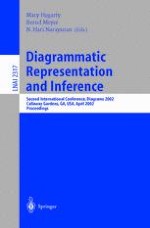2002 | OriginalPaper | Buchkapitel
Visual Attention and Representation Switching During Java Program Debugging: A Study Using the Restricted Focus Viewer
verfasst von : Pablo Romero, Richard Cox, Benedict du Boulay, Rudi Lutz
Erschienen in: Diagrammatic Representation and Inference
Verlag: Springer Berlin Heidelberg
Enthalten in: Professional Book Archive
Aktivieren Sie unsere intelligente Suche, um passende Fachinhalte oder Patente zu finden.
Wählen Sie Textabschnitte aus um mit Künstlicher Intelligenz passenden Patente zu finden. powered by
Markieren Sie Textabschnitte, um KI-gestützt weitere passende Inhalte zu finden. powered by
Java program debugging was investigated in programmers who used a software debugging environment (SDE) that provided concurrently displayed, adjacent, multiple and linked representations consisting of the program code, a functional visualisation of the program, and its output.A modified version of the Restricted Focus Viewer (RFV)[3] — a visual attention tracking system - was employed to measure the degree to which each of the representations was used, and to record switches between representations. Other measures included debugging performance (number of bugs identified, the order in which they were identified, bug discovery latencies, etc.).The aim of this investigation was to address questions such as ‘To what extent do programmers use each type of representation?’ and ‘Are particular patterns of representational use associated with superior debugging performance?’.A within-subject design, and comparison of performance under (matched) RFV/no-RFV task conditions, allowed the use of the RFV as an attention-tracking tool to be validated in the programming domain. The results also provide tentative evidence that superior debugging using multiple-representation SDE’s tends to be associated with a) the predominant use of the program code representation, and b) frequent switches between the code representation and the visualisation of the program execution.
